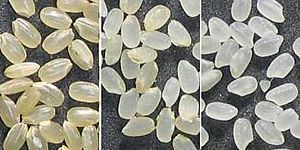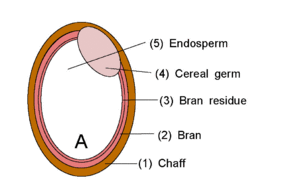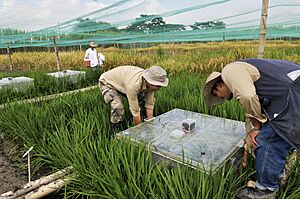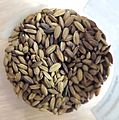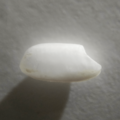Rice facts for kids
Quick facts for kids Rice |
|
|---|---|
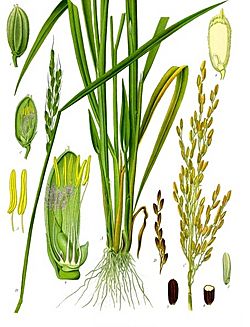 |
|
| Oryza sativa | |
| Scientific classification | |
| Kingdom: | |
| Division: | |
| Class: | |
| Order: | |
| Family: | |
| Genus: |
Oryza
|
Rice (Oryza sativa) is a very important type of grain. It is a main staple food for many people, especially in Asia. You can find rice growing in warm parts of the world, like Asia, Africa, northern Italy, and the west coast of North America.
People have eaten rice for a very long time. It is usually cooked before eating. In places like Spain, rice might be fried in oil first, then cooked with water or soup. In India, people often eat rice with tasty sauces or curry. Rice can even be used to make alcohol, like Japanese sake.
Contents
History of Rice
People believe that rice was first grown in ancient southern China and India around 2500 BC. That's about 4,500 years ago! Rice farming came to Japan possibly in the 1st century BC. It became very popular there during the 2nd and 3rd centuries. From India, rice farming then spread to southern Europe and Africa.
Where Does Rice Grow Best?
Rice grows best in special types of soil called alluvial loamy and clayey soil. It needs warm weather, usually around 24°C (75°F) or hotter, during planting, growing, and harvesting. Rice also needs a lot of rain, more than 100cm (about 40 inches) per year.
Places like river deltas, river valleys, flat coastal areas, and even terraced fields on mountainsides are perfect for growing rice.
How Farmers Grow Rice
Farmers usually plant rice in flat fields that are filled with water. These are called paddy fields. Before the rice is ready to harvest, the water is drained from the field. Long ago, before farmers had good farming systems and fertilizers, they would let their fields rest for one or two years. This helped the soil get its nutrients back.
In some hot areas near the equator, farmers can grow two crops of rice in one year. This is called double-cropping.
Types of Rice and What's Inside Them
Rice has a lot of carbohydrates, which give us energy. There are different kinds of rice.
Brown rice is rice that has only had its very outer layer removed. It has more fibre than regular white rice.
White rice is what most people think of as normal rice. It has had more layers removed, making it softer and quicker to cook.
What Does a Rice Plant Look Like?
A rice plant can grow to be about 1 to 1.8 meters (3 to 6 feet) tall. Some types can grow even taller, depending on the kind of rice and how good the soil is. The plant has long, thin leaves that are about 50 to 100 cm (20 to 40 inches) long and 2 to 2.5 cm (about 1 inch) wide.
The small flowers of the rice plant are pollinated by the wind. They grow in a branched cluster that hangs down, about 30 to 50 cm (12 to 20 inches) long. The part we eat is the seed, which is a grain about 5 to 12 mm (0.2 to 0.5 inches) long and 2 to 3 mm (0.08 to 0.12 inches) thick.
Cooking Rice
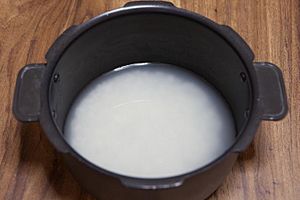
Rice grains are often grouped by their length: long-grain, medium-grain, and short-grain.
- Long-grain rice usually stays separate after cooking.
- Medium-grain rice becomes stickier when cooked. This type is used for sweet dishes, for risotto in Italy, and for dishes like arròs negre in Spain.
- Short-grain rice is often used for rice pudding. It's also the sticky rice used for sushi because it holds its shape well.
There's also Instant rice, which is already cooked and then dried. It's quick to make but doesn't taste as good as regular rice. Rice flour and starch are sometimes used in batters to make food extra crispy.
How to Prepare Rice
Many people rinse rice before cooking. This helps remove extra starch and makes the cooked rice less sticky. You might rinse rice several times until the water is clear. However, rice in the US often has extra vitamins and minerals added, and rinsing can wash these away.
Soaking rice before cooking can make it cook faster. It also saves fuel and can make the grains expand more, improving the texture. Rice can be soaked for 30 minutes to several hours.
Brown rice can be soaked in warm water for 20 hours to help it start to sprout. This process is called germinated brown rice (GBR). It makes the brown rice even healthier by activating enzymes and increasing good amino acids.
Rice is usually cooked by boiling or steaming. It soaks up water as it cooks. Many people use a rice cooker, which is a special electric pot that makes cooking rice very easy. Sometimes, rice is quickly fried in oil or fat before boiling. This makes the cooked rice less sticky. This style of cooking is called pilaf in places like Iran and Afghanistan, or biryani in India and Pakistan.
Popular Rice Dishes
Rice is used in countless dishes around the world!
- In Arab cuisine, rice is in many soups and dishes with fish, chicken, and other meats. It's also used to stuff vegetables or is wrapped in grape leaves.
- When mixed with milk, sugar, and honey, rice can become a delicious dessert.
- In some areas, like Tabaristan, bread is made using rice flour.
- Congee (also called rice porridge) is made by adding a lot of water to rice so it becomes very soft and mushy. It's often eaten for breakfast or when someone is sick.
Nutrition and benefits
| Nutritional value per 100 g (3.5 oz) | |
|---|---|
| Energy | 544 kJ (130 kcal) |
|
28.6 g
|
|
|
0.2 g
|
|
|
Protein
|
2.4 g
|
| Vitamins | Quantity
%DV†
|
| Thiamine (B1) |
2%
0.02 mg |
| Riboflavin (B2) |
2%
0.02 mg |
| Niacin (B3) |
3%
0.4 mg |
| Pantothenic acid (B5) |
8%
0.41 mg |
| Vitamin B6 |
4%
0.05 mg |
| Folate (B9) |
1%
2 μg |
| Minerals | Quantity
%DV†
|
| Calcium |
0%
3 mg |
| Iron |
2%
0.2 mg |
| Magnesium |
4%
13 mg |
| Manganese |
18%
0.38 mg |
| Phosphorus |
5%
37 mg |
| Potassium |
1%
29 mg |
| Sodium |
0%
0 mg |
| Zinc |
4%
0.4 mg |
| Other constituents | Quantity |
| Water | 69 g |
|
FoodData Central entry
|
|
| †Percentages estimated using US recommendations for adults. | |
Rice is a very important food for more than half of the people in the world. It provides a lot of the energy people need every day in many countries across Asia, Africa, and the Americas. Rice gives us about 20% of the world's daily energy, while wheat gives 19% and corn gives 5%.
Cooked white rice is mostly water (68%) and carbohydrates (28%). It also has some protein (3%) but very little fat. A 100-gram serving of cooked white rice gives you about 130 calories. It doesn't have a lot of vitamins or minerals. However, cooked short-grain white rice does have some B vitamins, iron, and manganese.
Rice Farming and Greenhouse Gases
In 2022, growing rice caused about 1.2% of all global greenhouse gas emissions. This is because rice fields that are flooded for a long time can release methane. Methane is a powerful greenhouse gas. It comes from tiny living things in the soil that don't get enough oxygen.
Farmers can help reduce these emissions. They can plant new types of rice, avoid continuous flooding, and remove old rice stalks. Using better water management, like "alternate wetting and drying," can cut methane emissions by a lot. It can even help grow more rice!
How Climate Change Affects Rice
Climate change can impact how much rice is grown. Some studies suggest that global rice yields might decrease as temperatures rise. For example, a rise of just 1°C (1.8°F) in global temperature could reduce rice yields by about 3.2%.
Rising temperatures and less sunlight have already reduced rice yields in some Asian countries. Rice plants also struggle to produce grains if the temperature is too hot (35°C or more) for over an hour. This means entire crops could be lost.
In Italy, some special rice varieties used for risotto have suffered from droughts. Scientists are working to create new rice types that can handle dry conditions better.
Rice in Culture
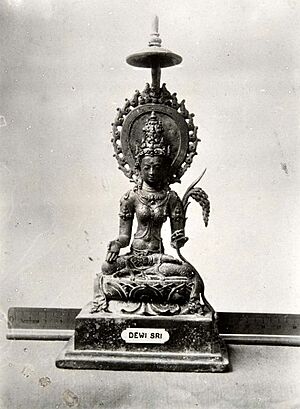
Rice is more than just food; it plays an important role in many cultures and traditions.
- In many Asian countries, rice is a symbol of life, fertility, and good fortune.
- In Hindu weddings, rice is thrown into the sacred fire. This tradition is similar to the Western custom of throwing rice over a newly married couple for good luck.
- Dewi Sri is a goddess in Indonesia who is believed to protect rice and bring a good harvest.
- In countries like Nepal and Cambodia, the start of the rice planting season is celebrated with special ceremonies.
Images for kids
-
A mixture of brown, white, and red indica rice, also containing wild rice.
-
Oryza sativa with small wind-pollinated flowers.
-
Cooked brown rice from Bhutan.
-
Jumli Marshi, brown rice from Nepal.
-
Oryza sativa, commonly known as Asian rice.
-
Burning of rice leftovers after harvest in Punjab, India. This helps prepare the land for planting wheat quickly.
-
A rice combine harvester in Katori-city, Chiba Prefecture, Japan.
-
After the harvest, rice straw is gathered in the traditional way from small paddy fields in Mae Wang District, Chiang Mai Province, Thailand.
-
Chloroxylon is used to help control pests in organic rice farms in Chhattisgarh, India.
See also
 In Spanish: Arroz para niños
In Spanish: Arroz para niños


